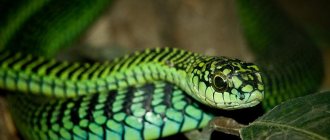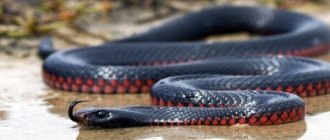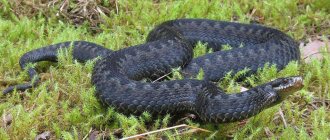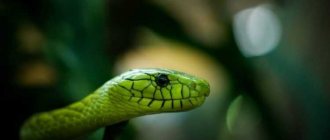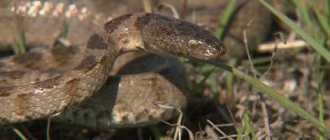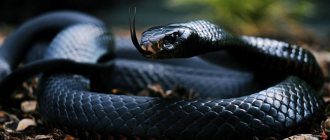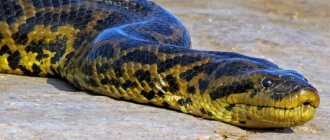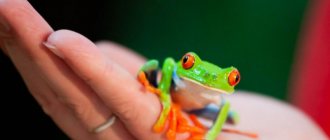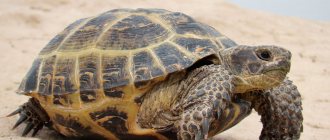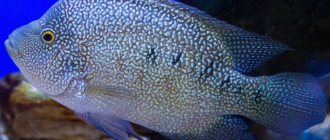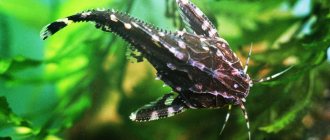External signs of a green mamba
The green mamba is a small, about 1.5 meter, dark green snake.
The head is oblong, rectangular in shape and separated from the body. Two large poisonous teeth are located in the front of the mouth. Non-poisonous teeth are found on both jaws. The green mamba's eyes have a large round pupil. They are constantly open, as they are protected by transparent shields, and not ordinary eyelids. The iris of the eyes is the same color as the scales of the skin.
Young green mambas, up to 7 cm long, are usually bright green or light green in color. Having reached a length of 70 cm, they darken and resemble an adult snake in body color.
The body color of the green mamba is shiny green with a lighter green-yellow belly. When the reptile bends its body, it shimmers in various shades of blue, green and yellow.
Is the composition of the poison known?
This is a rather complex mixture of active substances with a huge content of toxins. Many components of this liquid have not yet been studied or information about them is very superficial. The poison is a milky liquid, quite viscous in consistency.
Nowadays, scientists and herpetologists from the USA are actively studying the composition of the venom of pinnacle snakes. We hope that they will soon publish the results of their research.
Peculiarities of behavior of the green mamba
The green mamba is an arboreal snake and rarely comes to the ground. It is perfectly adapted to living among branches and leaves. The camouflage coloring and body shape make the green mamba completely invisible against the backdrop of the lush greenery of the tropical forest. Therefore, it is not so easy to notice it. Usually the green mamba is located on a tree, taking the form of a green branch. Here the reptile spends all its time: sleeps, eats, and rests during the hot period. The green mamba is generally a shy, non-aggressive snake.
She attacks only when she finds herself in a difficult situation or during a hunt. The green mamba is active during daylight hours, but seeing one on the ground is extremely rare. Only when carried away by the pursuit of prey can it descend to the ground or when it is resting, basking in the sun.
On tree branches, the green mamba periodically changes its location, moving from one tree to another.
Spreading
We have already said that the homeland of these snakes is Africa, but where exactly does the stiletto snake live? Its range is quite wide: the north-west of South Africa, Limpopo, KwaZulu-Natal, the tiny kingdom of Swaziland, the central and southern territories of Mozambique, Zimbabwe, Namibia and Botswana.
As you can see, the range of these snakes covers significant territories, and if we take into account the different climatic zones of their habitat, then we can confidently say that the pinnacle snakes perfectly adapt to various conditions: they are found in mountainous areas, which are densely covered with bushes, and in flatlands forests
Green mamba - an insidious snake
The green mamba is especially dangerous for local residents during the collection of tea leaves and mango fruits. Due to the presence of this reptile in plantations, work becomes dangerous for pickers. The green mamba hides among the green mass of leaves on the trees; it would seem that people are unlikely to disturb the dangerous reptile, but the fact of the matter is that when a person looks for a snake underfoot, in the grass and on the ground, it rushes from above.
The snake attacks without warning, and there is little chance of avoiding the bite. The poison acts so quickly that doctors do not even have time to administer anti-snake serum on the spot, let alone bring it to the nearest medical station. The bite causes a burning pain. As it spreads, the snake's venom eats away tissue and causes necrosis of the limbs. Scars remain on the affected areas of the body.
The snake instantly reacts to extraneous movements, so it often attacks people.
When traveling to areas where mamba are likely to live, guides always recommend wearing tight, close-fitting clothing. For some reason, green mambas tend to fall from the branches by the collar. It is very difficult to get it from there, and the poisonous reptile manages to inflict a fatal bite.
It is extremely difficult to see this green snake in the dense foliage. But all the same, in the habitats of the green mamba, you need to behave very carefully, looking at the grass under your feet and at the dense crowns of trees. Local residents, when they spot a green mamba, advise not to take risks, but simply bypass the dangerous place.
Differences from other species
The hairpin snake, armed with its terrible and poisonous fangs, has perfectly mastered the technique of lateral attack on its prey. How does a stiletto snake attack? This is the main feature of the species, since hunting underground in cramped conditions does not allow the use of any maneuvers, and a side blow with thin and long fangs always overtakes the target.
This unique tooth structure is the result of adaptation of burrowing animals to the lifestyle that is characteristic of the stiletto snake. Where she lives, she adapts to those conditions.
Fourth place – tiger snake
This is not a very common snake, which is found mainly in the Far East. The snake has a greenish color with orange “ears”, dark specks on the back. The level of danger of a snake is unpredictable - it does not have its own poison, but it is capable of absorbing toxic substances from the toads it eats; these toxins accumulate in the salivary glands of the snake.
When bitten, medical attention is required, as the concentration of the substance can reach a level where a person is fatal. But the bite may also be harmless.
copperheads
Copperheads are small snakes that live on the edges of forests. Copperheads feed mainly on lizards, sometimes insects.
Medyanka.
Although copperheads have poisonous teeth, their size is too small and their mouths are not capable of grabbing a person. Maybe by the finger of your hand. But even in this case, their bite does not pose a serious danger.
Just a hatched brood of copperheads.
Externally, the copperhead looks like a small viper. The diamond and zigzag patterns on the backs of copperheads are very similar to those of the pit viper.
Viper breeding
Now it’s time to talk about how viper snakes reproduce. Their mating season begins in the spring with the arrival of warmth.
The formation of eggs occurs in the womb. In the same place, small cubs hatch. They are released into the wild in August or September. One viper can give birth to up to 12 cubs.
Snakes are born this way. The viper wraps itself around the trunk. Holding her tail in the air, she scatters small reptiles across the surface of the earth. They are already adapted to life in natural conditions.
At the end of the article, you can watch a video that tells everything about the existence of the viper in natural conditions.
Characteristic
The genus Vipera, or true vipers, has about 30 species, of which 8 are common in Russia and Ukraine.
It is noteworthy that 5 species of this genus are included in the Red Book:
- Dinnika
- Kaznakova
- Nikolsky
- Stepnaya
- Gyurza
The common viper, which can be found in our forests, belongs to a separate genus Pelias berus.
It differs from the rest of its relatives in that its triangular head with a rounded muzzle is covered with three scutes: one frontal and two parietal.
Interesting! During the mating season, male vipers usually compete. This is how they gain the female's favor. Intertwining their bodies, the rivals rise and furiously hit each other with their heads until they fall from powerlessness. At the same time, they try to injure their opponent as little as possible. Sometimes such a duel lasts more than 30 minutes, but it always ends with one of the males giving way to the other and crawling away.
The color of the snake varies from light brown to black. There is a sinuous stripe of dark spots on the back
Lifestyle
Another surprisingly accurate name for this snake - southern stiletto - speaks of the extreme danger of this animal, which is predominantly nocturnal. This is a predator, always guided by smell. The snake doesn't see well. An excellent sense of smell compensates for the lack of vision caused by the lifestyle of the underground dweller. For most of the day, the stiletto snake hides underground, in loose sandy soil or fallen leaves, hunting rodents and other animals living in the upper soil layers. This snake has long and firmly won its reputation as a nest destroyer. She unerringly finds a rodent burrow underground, crawls into it and kills everyone who is in it - cubs and adults. Then he swallows them one by one. It appears on the surface rarely and at night, continuing to hunt lizards, amphisbaenus, small birds or snakes. In the family of pinnacle snakes there are also stenophagous species - species that eat only one specific type of prey. But for the most part, these reptiles hunt all types of small animals, kill them and swallow them.
Is there an antidote?
An encounter with an animal such as the stiletto snake, for which there is no antidote for its bite, is dangerous. Today, work is underway on the invention of an anti-snake vaccine, but so far there are no effective drugs. In world practice, special serums based on snake venom are used to save victims of a snake bite. Unfortunately, an antidote has not yet been invented for the bite of a stiletto snake. The lack of substances capable of neutralizing the destructive effect of the poison is a big problem for the large population of African territories. Today, like centuries ago, there is a high risk of attack by this small but very dangerous snake. We'll talk more about the consequences of a bite later.
What do vipers eat in nature?
The viper belongs to the predatory reptiles. Having noticed prey, the snake attacks it from ambush.
After a snake bite, the victim dies after some time from the volume of poison taken. Next, the viper eats the prey, looking at it completely.
Vipers often prefer to feed on small rodents, lizards or frogs. Small vipers eat large beetles and also prefer locusts or caterpillars.
